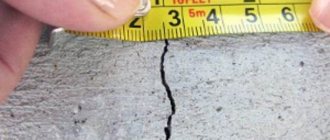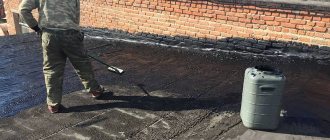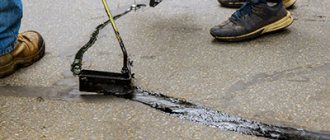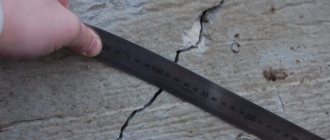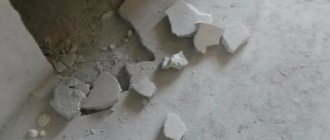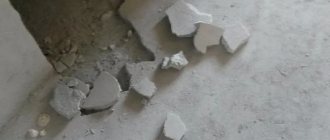If we consider the road surface system as a living organism, then cracks in the asphalt will act as foci of infection, which, without proper “treatment,” will slowly begin to undermine the entire organism and deplete more and more of its resources. As you know, roads are one of the “hot” three most pressing Russian problems. Its source in 90% of cases lies in poor service, poor quality and untimely repairs. As people say, “The miser pays twice.” So it turns out that in the pursuit of savings, roads patched ten times over, like a poor man’s bag, are destroyed, and in the end, repairs of cracks in the asphalt pavement are still required, which is much more expensive than partial repairs, but done on time. Let's talk in more detail about the causes of cracks and how to repair cracks in asphalt.
Types of cracks
There are three types of cracks:
- longitudinal,
- transverse,
- mesh.
The latter arise due to exposure to aggressive environmental conditions. This low level of pavement protection from the elements is usually caused by long-term use of asphalt and its “aging”. “Old” asphalt becomes covered with them in the same way as the skin of an aged person becomes covered with wrinkles.
Often, longitudinal cracks do not appear one at a time; they quickly find a “mate” and spread across the surface, like an infection.
Quite often, such cobwebs form on personal plots and in asphalted courtyards of private houses. Here the reason is completely different: the asphalt is not subject to the loads necessary to maintain its “elasticity”. Accordingly, the coating, without use, begins to “decrepit” in the literal sense of the word. The occurrence of longitudinal cracks is usually caused by violations of the manufacturing technology of the top layer of asphalt concrete mixture or its improper filling.
Constant temperature changes only aggravate the situation and turn repairmen’s mistakes into a real disaster. A large network of intricate interweavings of longitudinal and transverse cracks arises due to a combination of negative factors. Edge straight or crescent-shaped cracks along the side of the road occur due to the delamination of a certain part of the asphalt. The reason may be ground movement, shrinkage, or improper repairs in which the new coating was laid with errors.
Advice: to avoid such “asphalt disease” you need to use only high-quality materials and take into account all the nuances of the pavement laying process.
Repair of cracks in asphalt concrete pavements.
Work is carried out in spring or autumn (significant opening) and in summer-early morning, in dry weather at t0 >50, with a dry coating.
| Fig. 4. — Technological operations and technology options for eliminating cracks: 0 — state of cracks before the start of work; 1 - cleaning; 2 - drying and heating; 3 - coating; 4 - filling; 5 - a scattering of sand or small crushed stone; a - full cycle; b - without coating; c - without drying and heating; d - without cleaning, drying and coating; e - without drying, coating and sanding |
If the cleaning of cracks from dust and dirt is carried out or completed by blowing with hot air , then the operation of coating the crack with bitumen (primer) is eliminated, since the walls of the crack are covered with molten bitumen present in asphalt concrete (Fig. c ). When repairing in dry, warm weather, there is no need to dry the crack (Fig. c ). When repairing cracks using the surface treatment , the operations of cleaning cracks, drying, coating and filling with sand or stone fines are excluded (Fig. d and e ).
To perform crack repair work, various types of equipment are widely used, which are placed and mounted on a special road repair machine (road repairer).
Cleaning cracks from dust and dirt is the first, very important work operation for repairing cracks. The simplest way to perform this operation is to clean out the cracks with metal hooks and blow with compressed air. The best result is achieved when, before cleaning, the crack is moistened, cleaned with metal hooks or brushes, and then dried with compressed air.
Cracks with a width of 5 to 50 mm are cleaned with mechanical brushes having disks (with metal bristles) of different diameters and thicknesses (depending on the width) or manually with metal hooks; blown, dried and heated with a stream of hot compressed air.
High quality crack cutting is achieved by cutting grooves to a depth of up to 5 cm and a width of up to 3 cm with a milling cutter or circular saw, followed by removing dust, dirt and lubricants from the cracks. The result is a clean, correctly formed slot of the same width with vertical clean walls, which greatly facilitates all subsequent operations for sealing cracks and improves the quality of work.
In equipment kits for repairing cracks, they are cleaned with hot compressed air . Air from the compressor under pressure flows through a hose into a gas-jet (gasoline-air) thermal tool. The hot fuel-air mixture escapes from the burner at supersonic speed in a narrowly directed jet and, thanks to the high combustion temperature, cuts one- and two-layer asphalt concrete pavements. At the same time, the cut is cleared of small debris, dust and asphalt concrete destruction products. The edges of the cut or crack are melted, which promotes better adhesion of the asphalt concrete to the mastic poured into the crack.
When blowing through a crack without heating, before applying mastic, it is advisable to treat it with a solvent (or synthetic adhesive based on toluene). Filling of cracks should be done immediately after cleaning. Depending on the width of the cracks, various materials can be used to fill them. Narrow cracks up to 3-5 mm after cleaning are coated with liquid bitumen, and then using a crack filler they are filled with liquid or viscous liquefied bitumen or bitumen SG 130/120, MG 200/300, BND 200/300, heated to an operating temperature of 160-170 °C. After filling with bitumen, the cracks are sprinkled with sand.
Thin “young” cracks are also sealed by applying heated polymer-bitumen mastic in the form of a tape , which prevents the coating from chipping at the edges of the crack. The mastic is smoothed with a special heated iron (shoe) and sprinkled with fractionated sand. The coating in the crack zone is pre-dried with a heated stream of compressed air.
, medium and wide cracks up to 3 cm wide are treated with liquid bitumen at a rate of 0.1-0.15 l/m2 using a sprayer or spray gun and, using a joint filler dispensing gun, filled with rubber-bitumen mastic heated to 150-170°C. After this, sprinkle the surface with dry heated sand or stone fines. The work is carried out with grippers 100-200 m long.
The composition of the mastic for filling joints includes viscous bitumen, mineral powder, crumb rubber and short-fiber asbestos, which can be replaced with synthetic fibers.
Medium and wide cracks can also be filled with polymer bitumen binders, emulsion-mineral mixture, sand asphalt mixture or polymer concrete mixture. Very wide cracks of more than 3 cm are sealed with a fine-grained asphalt concrete mixture, having previously lubricated the crack walls with liquefied bitumen. After filling with asphalt concrete mixture, it is compacted with rollers weighing 5-6 tons. Cracks with a width of 50 mm or more are contoured with a joint cutter or jackhammers to the entire thickness of the coating, the destroyed material is selected, the mastic crushed stone mixture is laid in layers and sprinkled with sand.
If the crack is not cut to its full depth, then in order to avoid the appearance of a reflected crack, before sealing, a special sealing cord, a layer of bituminized sand or a layer of rubber crumb is placed at the bottom of the groove in the crack.
To simplify the technology for sealing cracks and improve the quality of these works, mastics with solid fillers are used, which are characterized by increased mechanical strength and thermal stability, which makes it possible to increase the service life of coatings after treatment by 2-2.5 times. The use of mastics with solid filler makes it possible to avoid sprinkling the filled crack with sand or seedings.
There is experience in filling wide cracks with crushed stone impregnated with bitumen and sealing with fiberglass strips, which are poured on top with bitumen, as well as experience in sealing the filled crack with a special bitumen tape, which is heated at the place where the gas burner is installed.
Cracks with damaged edges are cut by cutting out asphalt concrete in a strip of 10-15 cm on each side of the deformed layer. Cut cracks are repaired in the same way as potholes.
If there are cracks in a continuous network of coating in small areas, they are covered with surface treatment. A continuous network of cracks, which arose due to the instability of the base, is repaired in the same way as places of reduced strength - by cutting down the base and installing a new surface treatment.
To repair cracks, special sets of machines and equipment are produced (see video).
Sealing cracks with geotextile tapes.
To secure the repair material, you can seal the crack with a geotextile material with a tape width of 8-12 cm. A pre-prepared geotextile tape is immediately laid over the spilled bitumen, unwinding it from a coil mounted on a hand truck. The tape is applied to the bitumen and pressed against it with a pressure roller. The tape is glued to the bitumen.
Repairing cracks and preventing the formation of potholes by installing local surface treatments . The overwhelming number of potholes are formed as a result of the development of cracks, as well as places of peeling and chipping of crushed stones from the coating.
The most appropriate use of this technology is to repair small cracks at an early stage of their development, which helps prevent the formation of large cracks and potholes, i.e. practically avoid the need for pothole repair. This creates the basis for a preventative maintenance strategy.
What causes cracks in asphalt?
The reason for such a defect may lie in an error made at any stage of road construction. Moreover, the earlier a mistake was made in the process, the more difficult it will be to locally eliminate its consequences.
- Incorrectly conducted geological exploration. Before laying a road, the area must be studied by geologists. Particular attention is paid to the soil and its characteristics. Improper soil preparation will result in movement and settlement. Accordingly, the road will “walk” under your feet, and not a single asphalt can withstand this, and it’s good if the matter is limited to only cracks.
- Incorrectly laid foundation. The second stage of construction after exploration and design can also lead to catastrophic consequences. If the wrong slope was chosen or the base was improperly compacted, the coating will certainly settle after a short period of use. The main problem with such a mistake is that even after replacing the old cracked top layer with a new one, no one can guarantee that it will not suffer the same sad fate.
- Failure to comply with the conditions for laying the top layer. The asphalt concrete mixture must be at a certain temperature, unless of course we are talking about the so-called “cold asphalt”. If the temperature of the mixture drops below 120 degrees, then it is a priori considered defective and cannot be used. The temperature regime must be maintained in special “tanks” of equipment for transporting ABS. Their design resembles ordinary household thermoses. In this case, the ambient temperature must also be taken into account: in the cold season it is better to use “cold” asphalt concrete. It will not only “fit” better, but will also protect the base coating from sudden temperature changes. Otherwise, such a patch will become the source of a whole network of cracks later. A poorly prepared base will also have a negative impact on the future fate of such coating. You cannot lay asphalt in the rain. Water in this case is the worst enemy of road surfaces.
- Violations of the ABS “preparation” technology will also affect its quality. All its components must be properly prepared: sand and crushed stone are thoroughly washed, and bitumen and mineral powders are properly selected. Low quality raw materials naturally also cannot become the basis for strong and durable material.
- Freezing of water in the “pores” of asphalt . Hot asphalt concrete pavement, which is used in 90% of domestic roads, has a porous structure. When water stagnates and the temperature then drops to zero, the water in the clogged pores freezes. Everyone knows that the distance between water molecules increases and the pressure with which it seeks “free space” is colossal and can even tear apart metal pipes or stone blocks. Naturally, asphalt cannot withstand such a load.
Advice: in most cases of crack formation, the human factor is to blame. However, although nature does not have bad weather, sometimes it is climatic conditions that cause such a deplorable situation. And even here, quite often the road surface is simply not designed to withstand such aggressive environmental behavior, although it can be “strengthened” and protected properly during road construction.
RUE "Belstroytsentr"
The article analyzes the causes of cracks in road surfaces. Research by scientists on the development of criteria for the crack resistance of road surfaces and corresponding indicators of the resistance of asphalt concrete to cracking is noted. The choice of the correct criterion determines the success of measures to ensure the crack resistance of the coating.
The reasons for the appearance of cracks in road pavements have been analyzed in the article. The studies of scientists on development of pavement crack resistance criteria and corresponding parameters of asphalt concrete stability to crack formation have been noted. A choice of the correct criterion predetermines progress in measures on preventing crack formation in road pavements.
INTRODUCTION
Damage to road surfaces during operation significantly reduces their service life. Thus, instead of the expected 15–20 years, the most common asphalt concrete pavements in the republic fail in 6–8 years. Due to the lack of sufficient funds, repair work has been postponed indefinitely. As a result, the damage area can reach up to 60%–80% of the total coating area [1].
The main types of destruction of asphalt concrete pavements, depending on the nature, location and size, include cracks, potholes, patches, rutting, spalling, peeling, and destruction of edges [2]. The most typical type of damage is cracks. The main reasons for their formation are the influence of weather and climatic factors, transport loads, and changes in the properties of materials over time (Fig. 1).
Road pavements cannot be absolutely crack-resistant. However, the use of effective methods to combat cracking would increase the service life of coatings and reduce the costs of their maintenance and repair by increasing the resistance of layers to emerging cracks.
CAUSES OF CRACKS
Many scientists, like in our country - V. A. Verenko, V. N. Yaromko, V. P. Kryukov; in Russia - A. M. Boguslavsky, L. B. Gezentsvey, N. V. Gorelyshev, V. D. Kazarnovsky, V. A. Kretov, A. R. Krasnoperov, V. N. Kononov, B. S. Radovsky , A. V. Rudensky, Yu. E. Nikolsky, and abroad - D. Sousa, P. Paris, D. Cox, R. Wu, K. Monosmith, F. Zou, R. Litton, V. Kogale, – conducted research to study crack formation processes. Much work has been done both to improve the composition of asphalt concrete and to develop structural and technological measures to reduce cracking.
The main causes of destruction of the coating in the form of cracks are: the impact of transport loads, temperature changes from positive to negative, low negative temperatures, cracks and seams in the underlying layers, differences in the thermophysical properties of the materials of layers of adjacent coatings, uneven compaction of the roadbed and layers of road pavement, the formation of heaves , accompanied by the appearance of a network of cracks in the road pavement.
Depending on the nature, cracking takes different forms:
– reflected cracks (Fig. 2a): arise as a result of stress concentration in asphalt concrete above the seams and cracks of the base during movements of slabs and base blocks;
– temperature cracks (Fig. 2b): formed due to the occurrence of temperature stresses during cooling of the coating, usually after several years due to the aging of bitumen, due to which asphalt concrete loses its deformability at negative temperatures;
– power cracks (Fig. 2c): formed due to the occurrence of stresses from the action of a transport load with insufficient bearing capacity of the base and (or) with insufficient bending strength of asphalt concrete;
– technological cracks (Fig. 2d): they arise as a result of incorrect selection of the composition of the asphalt concrete mixture, violation of the technology of laying layers and compaction of the mixture, as well as in places of longitudinal and transverse junctions of adjacent strips of asphalt concrete pavement;
– fatigue cracks: they appear mainly in the form of transverse cracks on the lower surface of the road surface due to the deflection of layers of road pavement, then within 6–12 years, depending on traffic intensity and climatic factors, they grow through the entire thickness of the road surface; may also develop from the surface of the coating downwards.
Rice. 1. Types of deformations of the underlying coating layer,
promoting reflected cracking
A)
b)
V)
G)
Rice.
2. Types of cracks in road surfaces In any case, the main influence on the operation of road surfaces and the process of crack formation on them is exerted by transport loads and the entire complex of weather and climatic conditions. Under the influence of transport load, the asphalt concrete pavement bends; maximum tensile stresses arise in the lower zone, and their magnitude depends on the thickness of the pavement, the ratio of the elastic moduli of the pavement and the base [3].
In the summer, partially autumn and winter seasons, when the soil of the roadbed has high rigidity, as well as in any period for structures with bases of increased rigidity, under the influence of transport at the bottom of the monolithic layer (z = 0) under the center of the wheel imprint, as in layer surface (z = h), compressive horizontal normal stresses (+sу) arise (y = 0; z = 0) (Fig. 3). In the spring, when the soil of the roadbed is waterlogged, tensile stresses (-sу) (y = 0; z = 0) arise in the lower part of the covering (on the base), and surface tensile stresses (-sу) (y > y0 (z = h); z = h), as a rule, much less. In this case, at a certain distance y0 (z = 0), compressive horizontal normal stresses (+sу) will appear (y > y0 (z = 0); z = 0). At the same time, surface horizontal normal tensile stresses (-sу) (y > y0 (z = h); z = h) always arise on the coating surface at a distance y > y0 (z = h) [4].
As a result, single power cracks with branches and curvatures may form, located at different angles to the axis of the roadway. In addition, the action of a transport load can cause the appearance of reflected cracks in the upper layer of the pavement due to the vertical displacement of the lower asphalt concrete layer or cement concrete slabs that occurs when the wheel passes from one edge of the crack to the other (it is assumed that vertical displacements disrupt the continuity in the underlying layers) (Fig. 4) [5].
Rice. 3. Diagram of deflection of the coating under the action of loads from the wheel
Rice. 4. Mechanism of reflected cracking
under transport load
Important weather and climatic factors that influence the performance of road pavements include air temperature and humidity, solar radiation, and average precipitation. The impact of the above factors can cause in asphalt concrete pavements stretching from non-free compression during cooling, deformation from changes in the humidity of asphalt concrete with frequent temperature transitions through 0? coating with a temperature difference at the top and bottom of the coating.
Considering asphalt concrete layers on a cement concrete base, we note that daily temperature fluctuations cause not only horizontal movement in the cement concrete layer, they also cause bending and warping of the slab itself, which creates shear and tensile stresses in the lower part of the asphalt concrete layer above the seam or crack (Fig. 5) [6].
Rice. 5. Stresses in the asphalt concrete coating layer on a cement concrete base caused by daily temperature fluctuations
In addition to air temperature, solar radiation has a significant impact on the surface of the coating. The equivalent heating temperature of the coating by solar radiation, taking into account the dust content of the air, is determined by the formula
(1)
where r is the absorption coefficient;
I – intensity of solar radiation;
an – heat transfer coefficient;
Кз – dust coefficient.
As a result of daily temperature fluctuations, the phenomenon of thermal expansion-contraction, and the impact of solar radiation on the road surface, temperature and reflected cracks appear in the pavement. Temperature cracks form across the entire width of the pavement (transverse) with a clearly defined step of 2–25 m. Their appearance is caused by tensile stresses, which arise mainly due to sudden changes in air temperature: asphalt concrete becomes brittle, uneven cooling of the structural layers of the road pavement occurs and unfree contraction occurs. cooling coatings.
Some authors in their works cite the main reason for the appearance of reflected cracks as the effect of temperature fluctuations, which cause a concentration of thermal stresses in the upper layer of the coating or reinforcement, resulting in a breakdown of adhesion between the layers, or the crack is reflected into the overlying layer. Some studies suggest that thermal stresses are initiated by rapid cooling of the top layer, which leads to the emergence of critical tensile stresses that cause crack development. In addition, there are opinions that the most important effect is the opening of cracks as a result of bending of the road pavement structure (Fig. 6) [6, 7].
Rice. 6. Mechanisms of reflected cracking under the influence of temperature
The presence of traffic load has an adverse effect on the road surface mainly in the spring; cooling factors of the coating - especially strong when the temperature drops sharply, as a rule, at the beginning of winter and early spring. Consequently, the effect of these factors coincides with the time of year. However, maximum tensile stresses from movement occur in the lower zone of the coating, and from natural factors - in the upper zone, which allows us to make the assumption that crack resistance under traffic conditions does not depend on crack resistance under the influence of natural factors.
As for natural factors, the main one can be called the stretching of asphalt concrete due to unfree compression during cooling. In this case, crack resistance, according to B.I. Ladygin, is ensured only by adjusting the properties of asphalt concrete in accordance with the requirements for the appropriate climatic conditions.
JUSTIFICATION OF CRITERIA FOR CRACK RESISTANCE OF ROAD PAVEMENTS
Criteria for temperature crack resistance, both empirical and experimental-theoretical, were proposed by A. M. Boguslavsky, B. I. Ladygin, V. V. Mozgov, B. S. Radovsky. Much attention is paid to this issue in the works of V. A. Verenko.
Scientists all over the world attach importance to various factors that influence the intensity of cracking. In European countries, considerable attention is paid to research into the rheological properties of road bitumen and polymer-bitumen binders. In Japan, great importance is attached to the analysis of the results of field observations of the formation of cracks during the operation of asphalt concrete pavements: it has been established that the number of transverse cracks depends not only on climatic, transport and material science factors, but also on the design of the road pavement, including the coefficient of friction of asphalt concrete along underlying layer. Similar approaches to assessing crack resistance can be found in numerous publications by Russian scientists [8].
During the analysis of scientific publications, it can be noted that an integrated approach should prevail when assessing the crack resistance of asphalt concrete pavements. It is necessary to simultaneously take into account the design features of the road pavement, the properties of materials, temperature distribution gradients, external loads and many other factors. Therefore, the task of developing crack resistance criteria is not simple.
It has been proven that the crack resistance of asphalt concrete pavements depends on the rheological and strength properties of asphalt concrete, the design of the road pavement, and operating conditions. In turn, the strength of asphalt concrete is characterized by a pronounced time dependence, and the intensity of relaxation processes during the deformation and destruction of bitumen materials largely depends on temperature and the level of operating stresses [9].
In general, the resistance of a material to the appearance of cracks of various types is determined by its following properties: thermophysical (coefficient of linear thermal expansion), deformation (relaxation modulus at design low temperature), strength (ultimate structural strength) and fatigue (level of damage to the coating material) [10] .
Thermal expansion is the most important consideration when assessing the resistance of a material to thermal cracking. Most often, when assessing temperature crack resistance, the coefficient of linear expansion a, deg-1 is used
(2)
where l0 is the initial length of the sample, m;
Dl – elongation of the sample during heating (cooling), m, by temperature DT, oC.
Coefficient a is the most important when assessing the stress state of a coating material: the higher its values, the greater the unrealized thermal deformation and the higher the stress. If the linear expansion coefficient a is zero, the problem of temperature cracks does not arise.
According to studies conducted back in the 60s of the last century, A. M. Boguslavsky established numerical values of the coefficient of linear expansion depending on the type of asphalt concrete mixture and brand of binder (Table 1). In all cases, the coefficient of linear expansion of the base is assumed to be 0.00001, the cooling gradient (t1 - t2) = 10 degrees, the cooling time is 3600 s [11].
Table 1. Linear expansion coefficient values
| Mixture name | Linear expansion coefficient a |
| Warm fine grain | 0,00005 |
| Hot: | |
| sandy | 0,000068 |
| fine-grained | 0,00007 |
| fine-grained | 0,00007 |
| Cold | 0,00003 |
According to DMD 02191.9.005 [12], when determining the structural resistance of asphalt concrete to cracking after testing samples, the value of the linear expansion coefficient is calculated using formula (2), then the temperature stress of asphalt concrete when cooled to a temperature of minus 20 °C is determined using the formula
(3)
where at is the coefficient of linear expansion of asphalt concrete;
m – coefficient of transverse expansion of asphalt concrete (assumed equal to 0.1);
E – elastic modulus of asphalt concrete;
Kr – relaxation coefficient, depending on the type of binder and its viscosity; accepted: for bitumen BND 60/90 – 1.15; for bitumen BND 90/130 – 1.00; for bitumen BMA 100/130 – 0.70.
The choice of the correct criterion for the crack resistance of asphalt concrete is one of the conditions that predetermines the success of measures to ensure the crack resistance of asphalt concrete pavements. According to B.I. Ladygin, focusing on a criterion that does not characterize the actual operating conditions of asphalt concrete, its actual stress state, or the climatic features of the road construction area will not allow purposefully and effectively improving the quality of asphalt concrete.
The empirical crack resistance criteria adopted in the 60s of the last century are not a conclusion from theoretical considerations regarding the structural and mechanical properties of asphalt concrete and its stress state in road surfaces. Here are some of these “old” criteria: the compressive strength of asphalt concrete at a temperature of 0 °C should not exceed 120 kg/cm2 (GOST 9128-67); the deflection of the beam at a temperature of 0 °C must be at least 30 mm, at a temperature of minus 15 °C - at least 9 mm, and the tensile strength at a temperature of minus 15 °C must exceed the strength at a temperature of 0 °C (S. O. Gordeev). More justified criteria for assessing crack resistance are based on comparing the deformations or stresses occurring in the coating, calculated from various dependencies, with similar limit values for asphalt concrete [13].
Am. :
(4)
where a1, a2 – coefficient of thermal expansion at temperature q2 of asphalt concrete and base, respectively (0.00001);
q2, q1 – final and initial cooling temperatures;
E – elastic modulus;
u1 – cooling rate from q1 to q2;
u0 = 0.4 deg/h – equilibrium cooling rate at which internal stresses have time to relax;
m – Poisson’s ratio, depends on the viscosity of bitumen.
According to N.N. Ivanov, with sudden cooling, the limiting temperature deformation in terms of crack resistance will be equal to:
(5)
where a1 is the coefficient of thermal expansion of the coating;
(q1 - q2) – temperature drop during the time during which stress relaxation does not have time to occur (for example, 10 hours).
The temperature deformation calculated from various dependencies is compared with the maximum permissible residual deformation of asphalt concrete.
V. A. Verenko proposed a material science criterion for crack resistance (crack resistance index IT), reflecting the ability of the road surface material to resist the appearance of temperature cracks:
(6)
where R0 is the splitting strength at a temperature of 0? C and a strain rate of 3 mm/min;
RC – ultimate maximum structural strength.
It is now generally accepted that temperature crack resistance is ensured if the tensile stresses sT arising during cooling of the coating, taking into account the relaxation ability, do not exceed the long-term strength limit RDL:
(7)
The stresses arising in the asphalt concrete pavement during cooling were initially determined from the dependencies for the temperature stresses of elastic bodies:
(8)
where a is the coefficient of linear thermal expansion;
(q1 - q2) – temperature range in which asphalt concrete works during the cold season;
m – Poisson’s ratio (not always taken into account).
After discovering the rheological properties of asphalt concrete, N. N. Ivanov modified the expression
(9)
where q is the maximum possible temperature drop in 1 hour.
N.V. Gorelyshev obtained a new dependence that indirectly takes into account the phenomena of relaxation:
(10)
where en is the creep of asphalt concrete;
m – proportionality coefficient.
The long-term strength of asphalt concrete is consistent with the hypothesis of the irreversibility of the destruction process, expressed in the principle of linear summation of damage. Thus, the Bailey failure criterion makes it possible to calculate the service time of an asphalt concrete pavement before the formation of a crack using the finite element method (Fig. 7).
Rice. 7. Flowchart for calculating the time until a crack forms
on asphalt concrete pavement
In accordance with the Bailey criterion, to assess the crack resistance of asphalt concrete, it is necessary to know the totality of the values of tensile stresses in the pavement and the time of their action. It is accepted that tensile stresses in an asphalt concrete pavement arise as a result of transport loads, from a decrease in the temperature of asphalt concrete, from temperature contraction of adjacent slabs of a more rigid block base, from warping of base slabs due to a temperature gradient across their thickness and from uneven subsidence and swelling of the base.
The approach of B.I. Ladygin is also known, who received an expression for determining the durability (service life) of asphalt concrete by crack resistance T in years, taking into account the fact that at the moment of crack formation, the viscosity of asphalt concrete reaches the peak of the permissible viscosity according to crack resistance conditions:
(11)
where [h] is the limiting value of the viscosity of crack-resistant asphalt concrete at the design low temperature;
hn – initial viscosity of asphalt concrete at the same temperature (viscosity at the time of laying);
nc is the aging coefficient of asphalt concrete, expresses the annual growth rate of the logarithm of viscosity;
1.1 – coefficient of reduction of the initial viscosity to the conditionally initial one, corresponding to a linear change in the logarithm of viscosity over time.
An analysis of a large number of scientific publications and regulatory literature allows us to conclude that there are many approaches to assessing the crack resistance of road surfaces. However, the influence of transport loads, temperature fluctuations, and design features of the road pavement are to one degree or another taken into account in the crack resistance indicator, or the influence of several factors is taken into account simultaneously.
For a comprehensive assessment of crack resistance, it is necessary to determine by laboratory methods the temperature-time dependencies of tensile strength (long-term strength), temperature deformation, elastic modulus and thermal shrinkage coefficient of asphalt concrete. These data make it possible to estimate the operating time of asphalt concrete until the first crack appears in the road surface.
CONCLUSION
1 Damage that occurs in road surfaces during operation significantly reduces their service life. In this case, cracks make up 60% of the total number of coating failures. This indicates the relevance of the problem of cracking in road construction and the need to find effective solutions to increase the crack resistance of coatings and eliminate existing cracks.
2 Much work has been done by scientists both to improve the composition of asphalt concrete and to develop structural and technological measures to reduce cracking. The materials science approach is effective in preventing the occurrence of temperature cracks. Constructive solutions are aimed at combating reflected cracking, however, these measures are a temporary measure that can slow down the development of reflected cracks for up to 3–4 years. There is currently no effective comprehensive solution to the problem of crack formation on road surfaces, combining both a materials science approach and a structural and technological one.
3 In order to increase the service life of road pavements, the authors consider it advisable to include pavement crack resistance as one of the main criteria in the calculation of road pavements. The criterion for the crack resistance of asphalt concrete should characterize the actual operating conditions of the material, its actual stress state, and the climatic features of the area where the highway passes, which will make it possible to purposefully and effectively improve the quality and resistance of asphalt concrete to cracking. In addition, it is important to take into account the design features of the road pavement in this indicator.
BIBLIOGRAPHY
1. Nosov, V.P. Increasing the service life of road pavements is a strategic task of road science / V.P. Nosov // Automobile roads. – 2006. – No. 12. – P. 81–86.
2. Leonovich, I. I. Diagnostics and quality management of highways: textbook. allowance / I. I. Leonovich, S. V. Bogdanovich, I. V. Nesterovich. – Minsk: New knowledge, 2011. – 350 p.
3. Strength and durability of asphalt concrete / ed. B.I. Ladygina. – Minsk: Science and Technology, 1972. – 187 p.
4. The influence of surface horizontal tensile stresses on the crack resistance of asphalt concrete layers of road pavement, taking into account the distribution of wheel passages along the width of the roadway: tr. Odessa State Academy of Construction and Architecture, vol. 37; N. G. Chausov, M. N. Bondar, A. N. Besarab, V. N. Paratsa. – Odessa, 2010.
5. Mukhtar, M. Interlayer Stress Absorbing Composite (ISAC) for Mitigating Reflection Cracking in Asphalt Concrete Overlays, Project IHR-533, Report No. UILU-ENG-96-2006, Illinois Cooperative Highway Research Program, Illinois Department of Transportation / M. Mukhtar, B. Dempsey. – 1996.
6. Nunn, M. An investigation of reflection cracking in composite pavements in the United Kingdom, Proceedings of the 1st International RILEM Conference on Reflective Cracking in Pavements, Assessment and Control, Liege University, Belgium, Edited by J. M. Rigo et al., March 1989 .
7. Lytton, R. L. Use of Geotextiles for Reinforcement and Strain Relief in Asphaltic Concrete. Geotextiles and Geomembranes / R. L. Lytton. – 1989. – Vol. 8. – R. 217–237.
8. Design of asphalt concrete composition and methods of testing. Roads and bridges: overview information "SoyuzdorNII", vol. 6. – M., 2005.
9. Volkov, M. I. Road construction materials / M. I. Volkov, I. M. Borshch, I. M. Grushko, I. V. Korolev. – M.: Transport, 1975. – 527 p.
10. Verenko, V. A. Deformation and destruction of road surfaces: causes and solutions / V. A. Verenko. – Minsk: Belarusian Encyclopedia named after P. Brouki, 2008. – 304 p.
11. Boguslavsky, A. M. Fundamentals of the rheology of asphalt concrete / A. M. Boguslavsky, L. A. Boguslavsky. – M.: Higher School, 1972. – 199 p.
12. Recommendations for ensuring the structural stability of asphalt concrete under modern traffic loads: DMD 02191.9.005-2008. – Enter. 02/01/2009. – Minsk: Ministry of Transport, 2009. – 12 p.
13. Method for quantitative assessment of the temperature crack resistance of asphalt concrete pavements laid on foundations with seams and cracks: Tr. State Enterprise "RosdorNII", issue. 10; A. Kretov, V. D. Kazarnovsky, A. R. Krasnoperov. – M., 2000.
What methods can be used to repair cracks in asphalt pavement?
Pit method
The most common method of repairing roads with cracks is patching. Before repairing cracks in the asphalt pavement, it is prepared: defective areas are outlined. Pieces of asphalt are cut out with a special cutter, and it is important to touch not only the upper, but also the lower layers. The bottom of the resulting pit is thoroughly cleaned of crumbs, dust and debris. Then it is filled with hot bitumen emulsion and the asphalt concrete mixture is laid on top. Next, the area is compacted using manual vibrating plates.
Read on topic: Construction of dirt roads
This type of repair is considered the most common and cheapest. The only drawback of the technology is that pothole repair does not ensure sealing of the coating.
Jet-injection method
This method is cheap, but it is selective and is suitable only for those sections of the road that are not subject to heavy loads. Cracks are cleaned using a special device that pumps compressed air. Then the inner surface of the defect is treated with bitumen emulsion and filled with crushed stone. For fixing, crushed stone is also “impregnated” with the emulsion and compacted. The measure, of course, is quick and convenient, but is considered only as a temporary one, since after a certain period the cracks will still make themselves felt.
Method using cast asphalt concrete
The stage of preparing the coating for repair work is exactly the same as for simple pothole repair. The only difference: if there is a recycler, the removed layer of asphalt is recycled and reused. They fill the hole with it, compact it and pour cast asphalt concrete mixture on top. There is no need to compact this material. If the repair is carried out on a dangerous section of the road, to increase the adhesion of the patch to the tires, it is immediately sprinkled with black crushed stone and pressed into the coating.
Filling cracks with various types of polymers
The method is very effective: cleaned cracks are hermetically sealed with a special compound that will no longer allow water to pass through and will prevent further destruction of the coating, but such materials are usually expensive, so not every utility office can afford such a luxury.
Advice: any of the above methods can temporarily or permanently correct flaws in the top layer of the road surface, but are completely powerless in the case of foundation laying errors or soil defects. Only complete repair of the road surface and its replacement will help here.
Technology and materials for sealing cracks
Cracks in asphalt concrete form for many reasons, but one of the main ones is the freezing and thawing of moisture. As practice shows, even a small crack in winter can very quickly develop into a pothole that is dangerous for traffic.
It is important to eliminate these defects before the start of the warm season. Cracks also include joints at the boundaries of maps cut for patching or for cutting to control the thickness and quality of road pavement. In addition, if a thin layer or layers of wear are planned to be applied to a road section, the quality and durability of the preventive repairs performed depend on the elimination of all defects.
The main cause of cracks in asphalt concrete is the freezing and thawing of moisture.
Cracks are sealed using several methods and using several types of materials, usually bitumen-based.
Materials used to seal cracks
If we talk about cracks that have reached a critical size, then their sealing is carried out by processing the edges by cutting. In this case, the same materials are used as for patching - asphalt concrete mixtures (hot, cast, cold, mixtures of aggregate and binder). Regular cracks can be repaired by filling.
In this case the following applies:
- Bitumens of various brands. The advantage of this material is its low cost and high strength. It requires heating the material to a high temperature, as well as high-quality removal of moisture in the crack cavity.
- Emulsions (also, usually based on bitumen). Does not require heating to high temperatures. They have low viscosity and therefore completely fill the crack cavity. Almost all emulsions can be used even on wet asphalt concrete.
- Sealants - provide the best moisture insulation of the crack cavity. Indispensable when repairing critical surfaces (for example, on bridges). The only drawback of this material is its high cost.
In addition, when sealing cracks, pure quartz sand or, more often, sand from crushing screenings is used to fill the area of the repaired defect. This eliminates the possibility of bitumen (sealant) sticking to vehicle wheels and protects the repair site from excessive heating in hot weather.
Small cracks are repaired using the filling method, which uses bitumen, emulsions and sealants.
Crack sealing technology
The technology for sealing cracks is much simpler than patching, so it is very important to eliminate the defect before it develops. If you do this in time, you can save money. The process itself can be divided into the following stages:
- Preparing the material for sealing (if a cold emulsion or sealant is not used). Heating bitumen or emulsion in bitumen cookers or asphalt distributors.
- Cleaning cracks from dust and dirt; blowers with a powerful flow are usually used for this process. Remove foreign particles from the defect cavity as far as possible.
- Drying cracks. This stage is most often combined with cleaning. The same air flow dries the walls of the crack. Sometimes a hair dryer is used for this operation, a unit that heats the supplied air.
- Filling cracks with sealing material. It can be done either manually using a watering can or with a bitumen (emulsion) dispenser on a sleeve with a hose (fishing rod) usually included in the asphalt distributor.
- Sprinkling the sealed seam with sand or screenings.
To mechanize the process of sealing seams, machines for pothole repair and jet-injection road repair are also used. In this case, the sequence of operations is somewhat different from filling potholes with this technique:
- Blowing and drying of defects is carried out immediately (as with pothole repair).
- Then the cracks are filled with pure bitumen or emulsion (when repairing holes, it is supplied mixed with crushed stone).
- A layer of binder with crushed stone is applied over the repaired crack, just as during patching.
There are also two more recently developed methods for eliminating cracks; we’ll tell you more about them:
- Heating of asphalt concrete by infrared radiation. The method can be used for relatively small cracks no more than 1-2 millimeters. In this case, the entire asphalt heats up and the binder fuses and covers the cracks. The disadvantage of this method is that it does not have an effect on roads that were laid very long ago, where the bitumen has completely lost its plasticity (burnt out).
- Using a heat knife. A device similar to the tip of a tinsmith’s soldering iron (in the shape of a ship) is used; a thermal knife heated to the required temperature melts the upper layers, simultaneously supplying material for filling, and closing the crack. With its help, high quality crack sealing is achieved, but it is not always possible to achieve complete filling of the defect cavity.
Afterword
As an additional measure, a wear layer is also applied to the top main layer of asphalt using casting technology, which performs the protective function of the coating. It is precisely capable of providing sealing and preventing water from entering the asphalt “pores”. This addition is optimal for those types of repairs that cannot hermetically “clog” the crack. By the way, not all types of cracks can be repaired locally.
Read on topic: Pothole repair of asphalt roads
The “mesh” on old asphalt cannot be “treated” by any of the above methods; it can only be removed along with the coating, replacing it with a completely new one. It’s exactly the same story with crescent-shaped cracks and defects “along the edge” at the very curb. Here we are talking about tearing one layer of coating from another, and pouring polymer or applying a patch in this situation is the same as “poulticing a dead person,” as our people say. You should treat cracks as the first warning signs of a “disease” and quickly get rid of them, so that you don’t have to spend your entire budget on “treating” seriously damaged asphalt.





